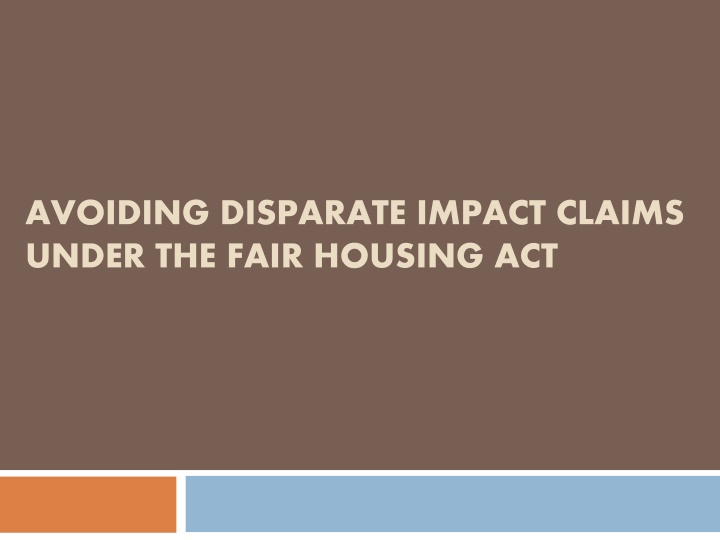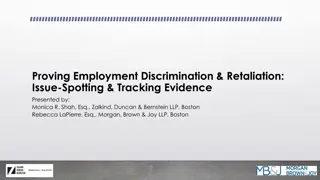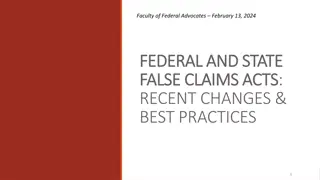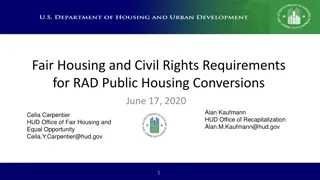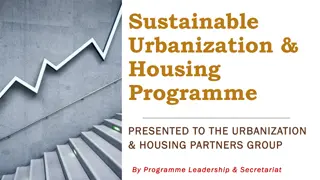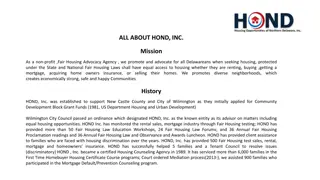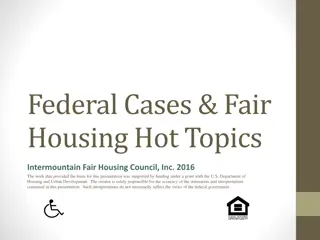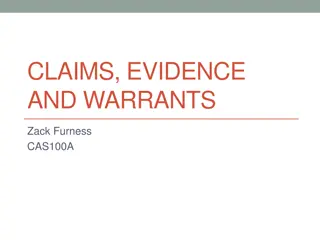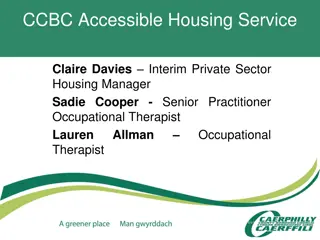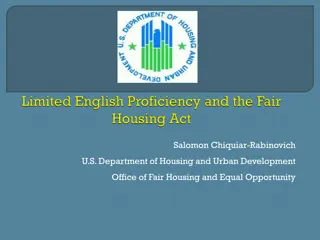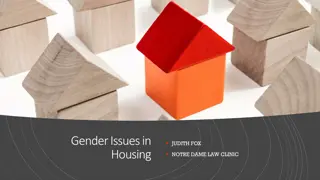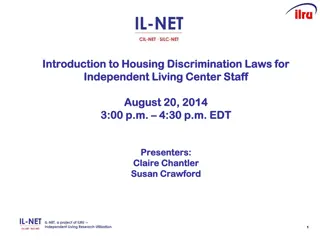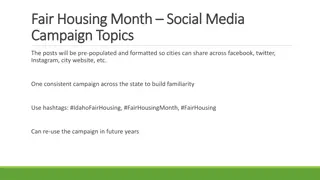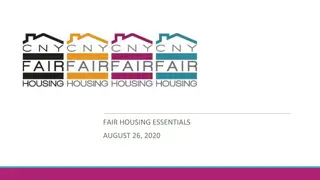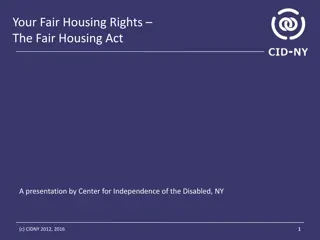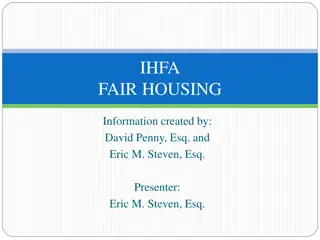Disparate Impact Claims Under Fair Housing Act
The Fair Housing Act prohibits discrimination based on protected classes. Disparate impact claims focus on policies or practices with discriminatory effects, without requiring intent. Learn about the Supreme Court's decision in limiting such claims to avoid abuse.
Download Presentation

Please find below an Image/Link to download the presentation.
The content on the website is provided AS IS for your information and personal use only. It may not be sold, licensed, or shared on other websites without obtaining consent from the author.If you encounter any issues during the download, it is possible that the publisher has removed the file from their server.
You are allowed to download the files provided on this website for personal or commercial use, subject to the condition that they are used lawfully. All files are the property of their respective owners.
The content on the website is provided AS IS for your information and personal use only. It may not be sold, licensed, or shared on other websites without obtaining consent from the author.
E N D
Presentation Transcript
AVOIDING DISPARATE IMPACT CLAIMS UNDER THE FAIR HOUSING ACT
The Fair Housing Act It is unlawful to make a dwelling unavailable to any person because of race, color, religion, sex, familial status, national origin, or handicap. 42 USC 3604(a)-(f) It is unlawful to discriminate against any person in a real estate related transaction (terms or conditions) because they are a member of a protected class. 42 USC 3605(a)
What is a Disparate Impact Claim? A policy or practice that has or will have a discriminatory effect [disproportionally adverse to a protected class]. Often neutral on its face. No requirement of discriminatory intent or motive. Liability based upon consequence of actions.
Texas Department of Housing and Community Affairs et al. v. Inclusive Communities Project, Inc. et al. U.S. Supreme Court decided June 25, 2015 Does the Fair Housing Act allow ICP to bring a disparate impact claim alleging the Department caused continued segregation housing patterns by allocating too many tax credits to housing in predominately black inner-city areas and too few to predominately white suburban neighborhoods?
Yes, but Scope of disparate income claims narrowed. USSC decision did not decide merits of claim
USSC Decision Focuses on Limiting Disparate Impact Claims to Avoid Abuse. Burden shifting Plaintiff s showing of statistical disparity alone is insufficient to make a prima facie disparate impact case Must also show how a neutral law, rule, or policy causes that disparity Disparate impact applies to general laws, rules, policies, or programs, not in the context of one-time decisions or actions Regulations necessary to achieve valid, non- discriminatory governmental interests can overcome demonstrations of disparate impact by plaintiffs
Burden Shifting Initial burden on Plaintiff to prove a challenged practice caused or will cause a discriminatory effect. If factors other than challenged practice, no causation, nor liability. Burden shifts to Defendant to prove that the challenged practice is necessary to achieve substantial legitimate nondiscriminatory interests.
Burden Shifting contd. Burden shifts back to Plaintiff to prove that the Defendant s nondiscriminatory interests could be served by another practice that has a less discriminatory effect. Plaintiff must show that there is an available alternative practice that has less disparate impact and will still serve the entities legitimate needs. Disparate impact liability mandates the removal of artificial, arbitrary and unnecessary barriers, not the displacement of valid governmental policies.
The Remedy in Disparate Impact Cases The remedy for disparate impact cases should concentrate on the elimination of the offending practice. Government and private priorities must be achieved without arbitrarily creating discriminatory effects or perpetuating segregation.
Disparate Impact Case Examples Tax Credit allocation Zoning law preventing construction of multifamily dwellings Ordinance restricting rental of housing to relatives
Practical Implications Review ALL general laws, policies, rules or programs for unintentional income segregation Which is likely correlated with racial/ethnic segregation
Practical Implications Before adopting any policy or practice, ask: likelihood to negatively impact a protected class compared to the general population? necessity to achieve substantial legitimate, non- discriminatory interest? option of a less discriminatory alternative?
Barriers can include: Local Land Use & Zoning barriers Restrictions on use Higher quality standards for some types of facilities Additional procedural steps for some types of facilities (allowed by-right vs. CUP) Minimum lot sizes Be aware of exclusions/limits on attached or multifamily housing and group homes
Other barriers can include: Allocation of housing funds Housing provider tenant Housing provider application Lender loan issuance Homeowner insurance rating
Considerations/Action Steps Due diligence in terms of research and siting of housing projects Strategic Planning Educate decision makers Data supported decision making Local governments to consider avenues for reasonable accommodations
Data & Mapping Current & Trend data Demographics & mapping: Community Neighborhoods Tenants/Owners Subsidized/Assisted Housing Usage & location Proximity to services/transit/jobs Geographic barriers Neighborhood Affinity vs. Gentrification
Resources HUD Disparate Impact Final rule issued February 2013 - HUD 24 CFR 100.500 http://www.huduser.gov/portal/affht_pt.html#dat aTool-tab In proposed guidance on the obligation to Affirmatively Further Fair Housing released in July 2013, HUD announced the creation of a uniform data set to assist program participants in identifying housing needs and conducting disparate impact analyses
